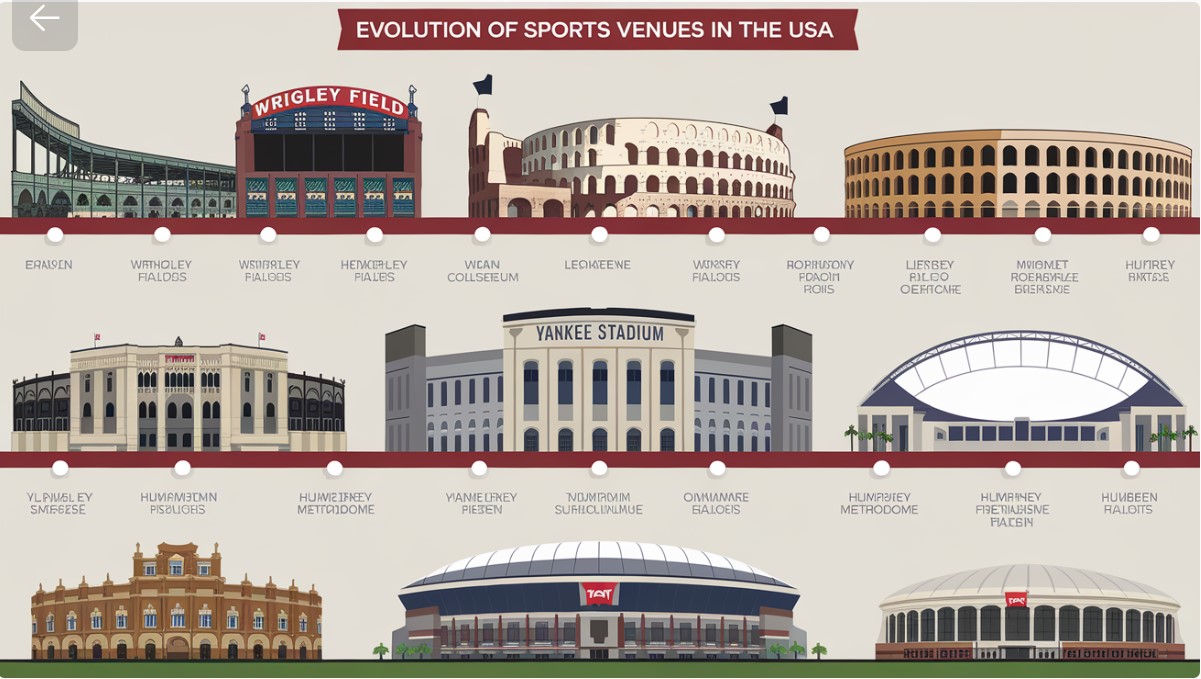Sports venues in the USA have evolved dramatically over the years, reflecting changes in technology, fan engagement, and societal values. From the wooden grandstands of the early 20th century to today’s ultra-modern stadiums, these venues not only serve as homes for athletic competition but as cultural landmarks. The evolution of sports venues offers a unique lens into American history and a preview of what lies ahead. This article will explore how these venues have changed, where they stand today, and what the future holds for sports arenas in the USA.
The Past: Origins and Traditions of Early Sports Venues :
The earliest sports venues in the USA were simplistic in design and focused solely on accommodating spectators for live events. These stadiums were constructed primarily of wood and had little to no consideration for comfort or amenities.
1. Wooden Grandstands (Early 1900s)
During the late 19th and early 20th centuries, wooden grandstands were a common sight in sports venues. The design was practical, focused on housing as many fans as possible with minimal architectural flare. Fenway Park, opened in 1912, and Wrigley Field, established in 1914, are perfect examples of this era. They offered nothing more than a seat and a view of the game, with little attention given to fan experience or safety, which sometimes resulted in stadium collapses.
2. Concrete and Steel Era (1920s-1960s)
The next major evolution in sports venues came with the construction of larger, more permanent stadiums made from steel and concrete. Yankee Stadium, which opened in 1923, was one of the first sports venues to use modern materials and set the tone for future stadiums. These venues were not only bigger but also more durable, reflecting the growing popularity of sports like baseball and football.
- Key Highlight: The rise of purpose-built venues for single sports like baseball or football, instead of multi-use fields, allowed these venues to serve as homes to iconic teams.
[Top 10 Upcoming Sporting Events in the USA: Don’t Miss These]
The Present: Modern Sports Venues and Fan-Centric Design
Modern sports venues have evolved into architectural marvels focused on fan engagement. The evolution of sports venues in the USA has shifted from just housing fans to providing complete entertainment experiences. Multi-purpose stadiums now serve as hubs for concerts, conventions, and events beyond sports.
1. State-of-the-Art Stadiums
Today’s sports venues feature cutting-edge technology, including HD screens, Wi-Fi access, and retractable roofs. AT&T Stadium, home of the Dallas Cowboys, exemplifies the modern sports venue, boasting one of the world’s largest HD video screens.
Key Highlight: New stadiums enhance fan experiences with tech features like augmented reality (AR) and mobile services such as in-seat food delivery.
2. Sustainability and Environmental Considerations
Modern stadiums emphasize eco-friendly designs. LEED-certified venues like Levi’s Stadium focus on sustainability with solar panels and water conservation systems.
Key Highlight: Environmental responsibility aligns with the cultural shift towards sustainability, evident in today’s stadium designs.
3. Fan Engagement and Premium Experience
Stadiums now focus on fan engagement with VIP lounges, luxury suites, and interactive zones. The concept of “smart stadiums” offers digital interaction, with apps guiding fans from parking to post-game activities.
The Future: What’s Next for Sports Venues in the USA?
The evolution of sports venues in the USA continues, with future stadiums promising more interactive and immersive experiences.
1. Smart Venues and Virtual Reality (VR)
Future venues will integrate VR, allowing fans to experience games from unique perspectives, such as a quarterback’s view. SoFi Stadium in Los Angeles is already exploring these technologies.
Key Highlight: VR and AR offer fans unique vantage points, enhancing the in-game experience.
2. Hyper-Personalized Fan Experience
Future venues will leverage AI to offer personalized experiences. Analytics could predict fan preferences, from seating to food options, enhancing overall satisfaction.
3. Sustainability Will Continue to Lead the Charge
Expect future stadiums to become carbon-neutral, incorporating advanced energy solutions and waste reduction programs. Self-sufficient venues will produce energy through renewable sources like solar power.
4. Multi-Purpose Mega-Complexes
Stadiums will evolve into entertainment complexes, offering year-round attractions like hotels, retail spaces, and theme parks.
The evolution of sports venues in the USA mirrors the country’s love for sports, reflecting changes in culture, architecture, and technology. From early wooden bleachers to today’s high-tech arenas, these venues enhance fan experiences while adapting to societal shifts. Looking ahead, sports venues will continue to innovate, creating new ways to engage fans and remain cultural landmarks.
More Info :


